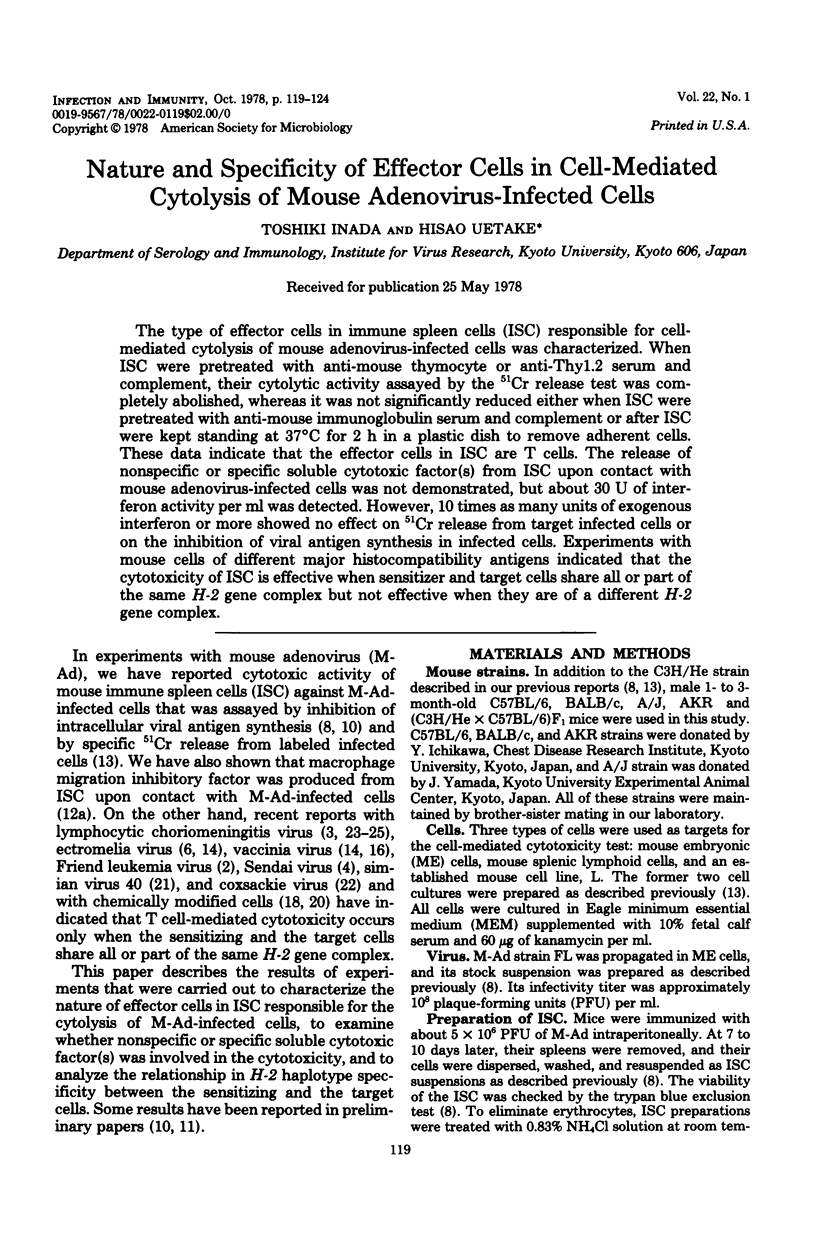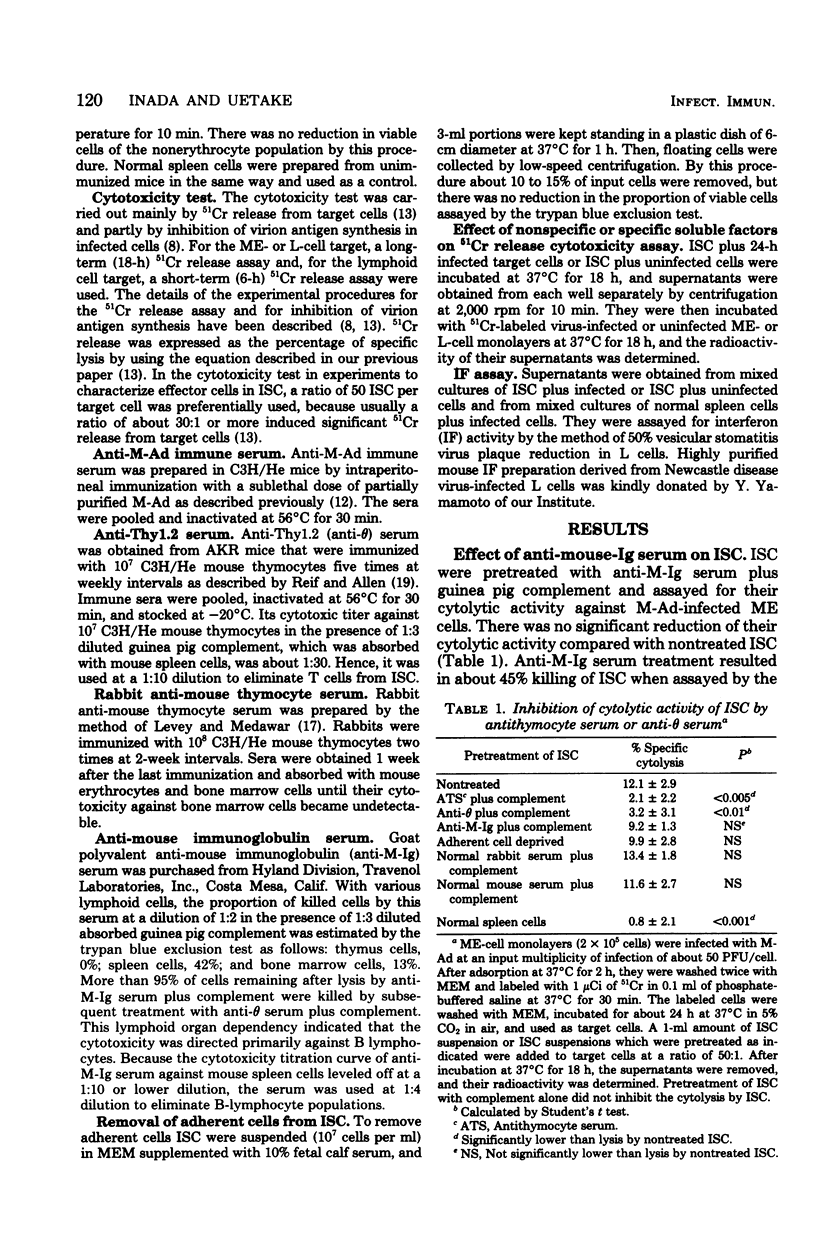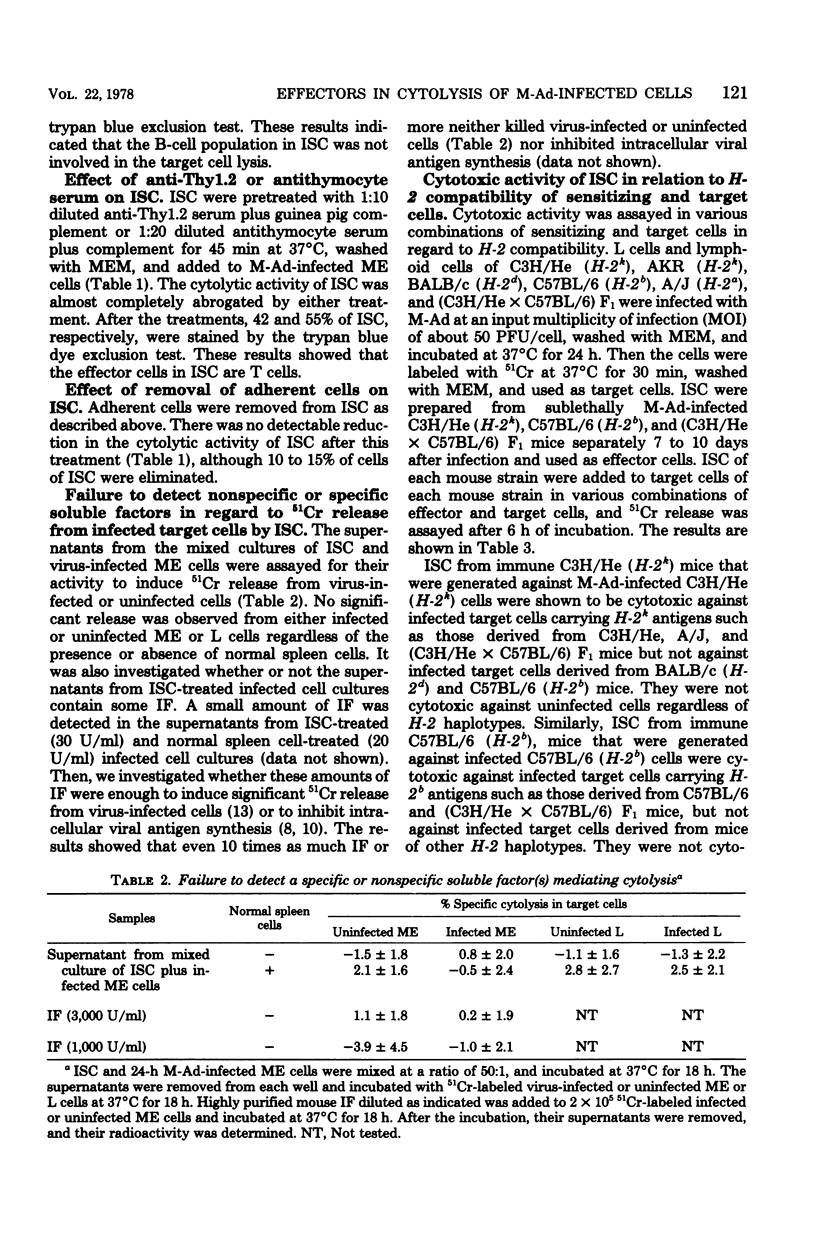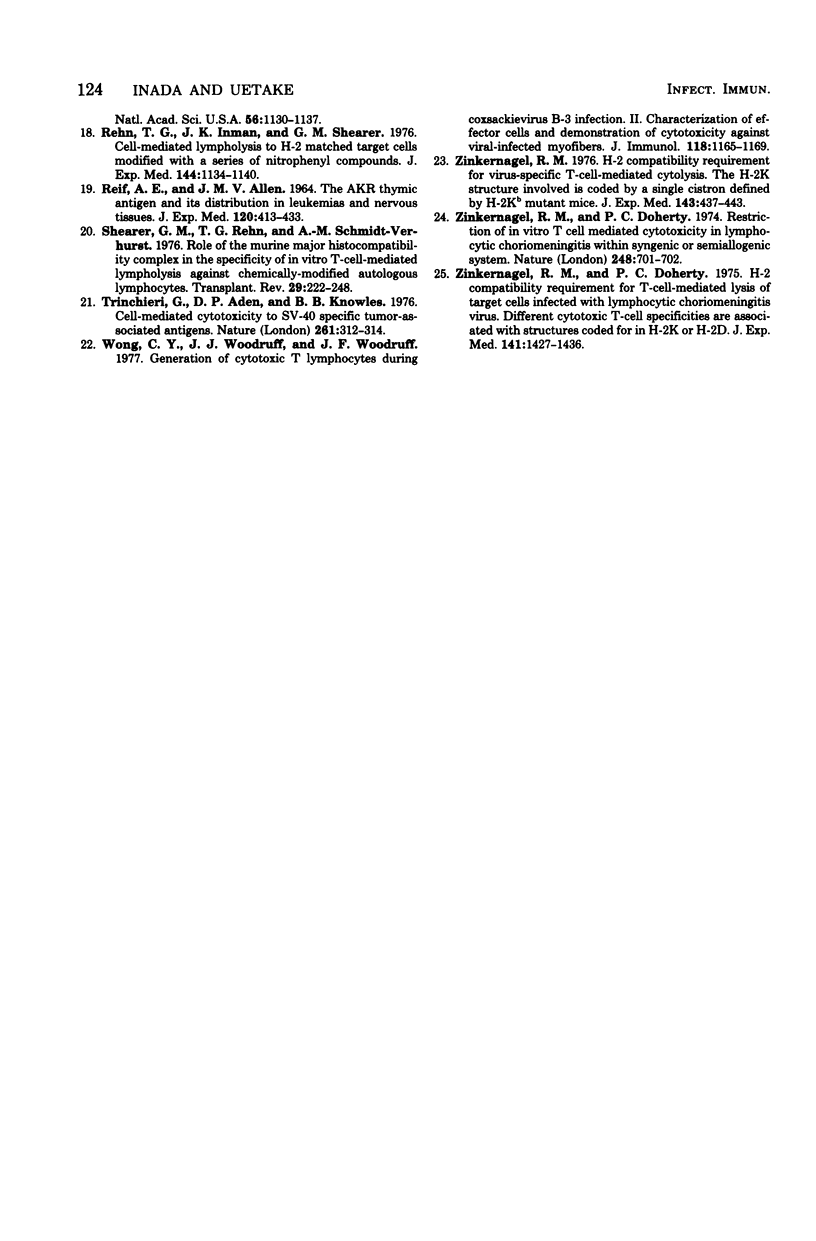Abstract
The type of effector cells in immune spleen cells (ISC) responsible for cell-mediated cytolysis of mouse adenovirus-infected cells was characterized. When ISC were pretreated with anti-mouse thymocyte or anti-Thy1.2 serum and complement, their cytolytic activity assayed by the 51Cr release test was completely abolished, whereas it was not significantly reduced either when ISC were pretreated with anti-mouse immunoglobulin serum and complement or after ISC were kept standing at 37°C for 2 h in a plastic dish to remove adherent cells. These data indicate that the effector cells in ISC are T cells. The release of nonspecific or specific soluble cytotoxic factor(s) from ISC upon contact with mouse adenovirus-infected cells was not demonstrated, but about 30 U of interferon activity per ml was detected. However, 10 times as many units of exogenous interferon or more showed no effect on 51Cr release from target infected cells or on the inhibition of viral antigen synthesis in infected cells. Experiments with mouse cells of different major histocompatibility antigens indicated that the cytotoxicity of ISC is effective when sensitizer and target cells share all or part of the same H-2 gene complex but not effective when they are of a different H-2 gene complex.
Full text
PDF





Selected References
These references are in PubMed. This may not be the complete list of references from this article.
- Bevan M. J. The major histocompatibility complex determines susceptibility to cytotoxic T cells directed against minor histocompatibility antigens. J Exp Med. 1975 Dec 1;142(6):1349–1364. doi: 10.1084/jem.142.6.1349. [DOI] [PMC free article] [PubMed] [Google Scholar]
- Blank K. J., Freedman H. A., Lilly F. T-lymphocytes response to Friend virus-induced tumour cell lines in mice of strains congenic at H--2. Nature. 1976 Mar 18;260(5548):250–252. doi: 10.1038/260250a0. [DOI] [PubMed] [Google Scholar]
- Doherty P. C., Zinkernagel R. M. H-2 compatibility is required for T-cell-mediated lysis of target cells infected with lymphocytic choriomeningitis virus. J Exp Med. 1975 Feb 1;141(2):502–507. doi: 10.1084/jem.141.2.502. [DOI] [PMC free article] [PubMed] [Google Scholar]
- Doherty P. C., Zinkernagel R. M. Specific immune lysis of paramyxovirus-infected cells by H-2-compatible thymus-derived lymphocytes. Immunology. 1976 Jul;31(1):27–32. [PMC free article] [PubMed] [Google Scholar]
- Gardner I. D., Bowern N. A., Blanden R. V. Cell-medicated cytotoxicity against ectromelia virus-infected target cells. III. Role of the H-2 gene complex. Eur J Immunol. 1975 Feb;5(2):122–127. doi: 10.1002/eji.1830050210. [DOI] [PubMed] [Google Scholar]
- Gardner I., Bowern N. A., Blanden R. V. Cell-mediated cytotoxicity against ectromelia virus-infected target cells. II. Identification of effector cells and analysis of mechanisms. Eur J Immunol. 1974 Feb;4(2):68–72. doi: 10.1002/eji.1830040203. [DOI] [PubMed] [Google Scholar]
- Gordon R. D., Simpson E., Samelson L. E. In vitro cell-mediated immune responses to the male specific(H-Y) antigen in mice. J Exp Med. 1975 Nov 1;142(5):1108–1120. doi: 10.1084/jem.142.5.1108. [DOI] [PMC free article] [PubMed] [Google Scholar]
- HARTLEY J. W., ROWE W. P. A new mouse virus apparently related to the adenovirus group. Virology. 1960 Jul;11:645–647. doi: 10.1016/0042-6822(60)90109-4. [DOI] [PubMed] [Google Scholar]
- Hamada C., Uetake H. Mechanism of induction of cell-mediated immunity to virus infections: in vitro inhibition of intracellular multiplication of mouse adenovirus by immune spleen cells. Infect Immun. 1975 May;11(5):937–943. doi: 10.1128/iai.11.5.937-943.1975. [DOI] [PMC free article] [PubMed] [Google Scholar]
- Inada T., Uetake H. Cell-mediated immunity assayed by 51Cr release test in mice infected with mouse adenovirus. Infect Immun. 1978 Apr;20(1):1–5. doi: 10.1128/iai.20.1.1-5.1978. [DOI] [PMC free article] [PubMed] [Google Scholar]
- Inada T., Uetake H. Cell-mediated immunity to mouse adenovirus infection. Macrophage migration inhibition test. Microbiol Immunol. 1978;22(7):391–401. doi: 10.1111/j.1348-0421.1978.tb00385.x. [DOI] [PubMed] [Google Scholar]
- Inada T., Uetake H. Virus-Induced Specific Cell Surface Antigen(s) on Mouse Adenovirus-Infected Cells. Infect Immun. 1977 Oct;18(1):41–45. doi: 10.1128/iai.18.1.41-45.1977. [DOI] [PMC free article] [PubMed] [Google Scholar]
- Kees U., Blanden R. V. A single genetic element in H-2K affects mouse T-cell antiviral function in poxvirus infection. J Exp Med. 1976 Feb 1;143(2):450–455. doi: 10.1084/jem.143.2.450. [DOI] [PMC free article] [PubMed] [Google Scholar]
- Koszinowski U., Ertl H. Lysis mediated by T cells and restricted by H-2 antigen of target cells infected with vaccinia virus. Nature. 1975 Jun 12;255(5509):552–554. doi: 10.1038/255552a0. [DOI] [PubMed] [Google Scholar]
- Koszinowski U., Thomssen R. Target cell-dependent T cell-mediated lysis of vaccinia virus-infected cells. Eur J Immunol. 1975 Apr;5(4):245–251. doi: 10.1002/eji.1830050405. [DOI] [PubMed] [Google Scholar]
- REIF A. E., ALLEN J. M. THE AKR THYMIC ANTIGEN AND ITS DISTRIBUTION IN LEUKEMIAS AND NERVOUS TISSUES. J Exp Med. 1964 Sep 1;120:413–433. doi: 10.1084/jem.120.3.413. [DOI] [PMC free article] [PubMed] [Google Scholar]
- Rehn T. G., Inman J. K., Shearer G. M. Cell-mediated lympholysis to H-2-matched target cells modified with a series of nitrophenyl compounds. J Exp Med. 1976 Oct 1;144(4):1134–1140. doi: 10.1084/jem.144.4.1134. [DOI] [PMC free article] [PubMed] [Google Scholar]
- Shearer G. M., Rehn T. G., Schmitt-Verhulst A. M. Role of the murine major histocompatibility complex in the specificity of in vitro T-cell-mediated lympholysis against chemically-modified autologous lymphocytes. Transplant Rev. 1976;29:222–246. doi: 10.1111/j.1600-065x.1976.tb00203.x. [DOI] [PubMed] [Google Scholar]
- Trinchieri G., Aden D. P., Knowles B. B. Cell-mediated cytotoxicity to SV40-specific tumour-associated antigens. Nature. 1976 May 27;261(5558):312–314. doi: 10.1038/261312a0. [DOI] [PubMed] [Google Scholar]
- Wong C. Y., Woodruff J. J., Woodruff J. F. Generation of cytotoxic T lymphocytes during coxsackievirus tb-3 infection. II. Characterization of effector cells and demonstration cytotoxicity against viral-infected myofibers1. J Immunol. 1977 Apr;118(4):1165–1169. [PubMed] [Google Scholar]
- Zinkernagel R. M., Doherty P. C. H-2 compatability requirement for T-cell-mediated lysis of target cells infected with lymphocytic choriomeningitis virus. Different cytotoxic T-cell specificities are associated with structures coded for in H-2K or H-2D;. J Exp Med. 1975 Jun 1;141(6):1427–1436. doi: 10.1084/jem.141.6.1427. [DOI] [PMC free article] [PubMed] [Google Scholar]
- Zinkernagel R. M., Doherty P. C. Restriction of in vitro T cell-mediated cytotoxicity in lymphocytic choriomeningitis within a syngeneic or semiallogeneic system. Nature. 1974 Apr 19;248(5450):701–702. doi: 10.1038/248701a0. [DOI] [PubMed] [Google Scholar]
- Zinkernagel R. M. H-2 compatibility requirement for virus-specific T-cell-mediated cytolysis. The H-2K structure involved is coded by a single cistron defined by H-2Kb mutant mice. J Exp Med. 1976 Feb 1;143(2):437–443. doi: 10.1084/jem.143.2.437. [DOI] [PMC free article] [PubMed] [Google Scholar]


